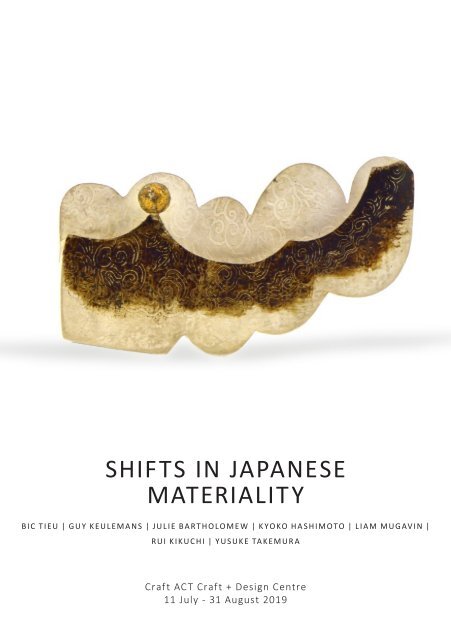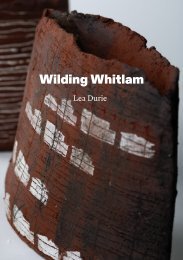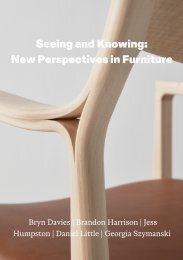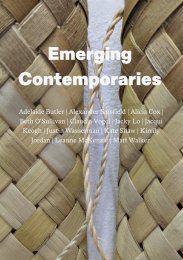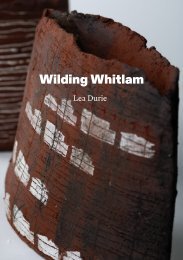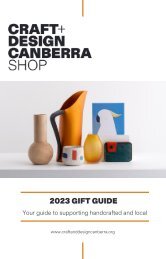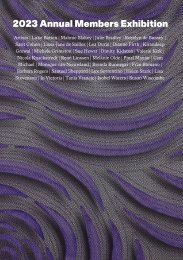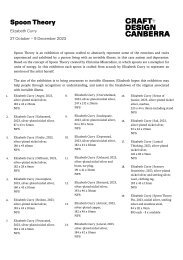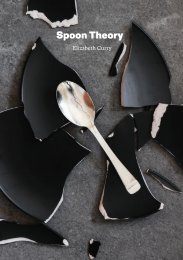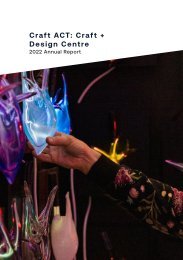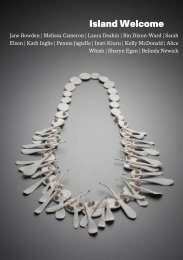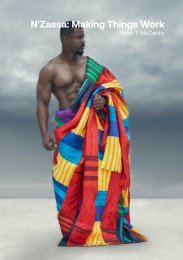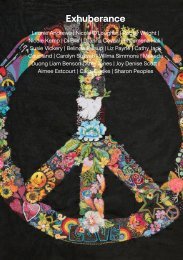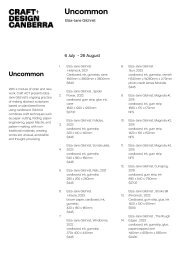Shifts in Japanese Materiality
11 July – 31 August 2019 Bic Tieu | Guy Keulemans | Julie Bartholomew | Kyoko Hashimoto | Liam Mugavin | Rui Kikuchi | Yusuke Takemura This group exhibition of contemporary design practice considers the changing nature of materiality in Japanese object-making culture. Through the work of experimental Japanese and Australian designers, Shifts in Japanese Materiality highlights the porosity of Japanese design and craft processes in a contemporary context.
11 July – 31 August 2019
Bic Tieu | Guy Keulemans | Julie Bartholomew | Kyoko Hashimoto | Liam Mugavin | Rui Kikuchi | Yusuke Takemura
This group exhibition of contemporary design practice considers the changing nature of materiality in Japanese object-making culture. Through the work of experimental Japanese and Australian designers, Shifts in Japanese Materiality highlights the porosity of Japanese design and craft processes in a contemporary context.
You also want an ePaper? Increase the reach of your titles
YUMPU automatically turns print PDFs into web optimized ePapers that Google loves.
SHIFTS IN JAPANESE<br />
MATERIALITY<br />
BIC TIEU | GUY KEULEMANS | JULIE BARTHOLOMEW | KYOKO HASHIMOTO | LIAM MUGAVIN |<br />
RUI KIKUCHI | YUSUKE TAKEMURA<br />
Craft ACT Craft + Design Centre<br />
11 July - 31 August 2019
Craft ACT: Craft + Design Centre is supported by the<br />
ACT Government, the Visual Arts and Craft Strategy –<br />
an <strong>in</strong>itiative of the Australian State and Territory Governments,<br />
and the Australia Council for the Arts – the<br />
Australian Government’s arts fund<strong>in</strong>g and advisory<br />
body.<br />
CRAFT ACT CRAFT + DESIGN CENTRE<br />
Tues–Fri 10am–5pm<br />
Saturdays 12–4pm<br />
Level 1, North Build<strong>in</strong>g, 180 London<br />
Circuit, Canberra ACT Australia<br />
+61 2 6262 9333<br />
www.craftact.org.au<br />
Front cover: Bic Tieu, Mapp<strong>in</strong>g Floral Imagery: Moon Sea<br />
Light series brooch, 2017, sterl<strong>in</strong>g silver, f<strong>in</strong>e silver, urushi,<br />
copper, gold leaf, mother of pearl, and sta<strong>in</strong>less steel.<br />
Photo: Gav<strong>in</strong>o Pili.<br />
2
SHIFTS IN JAPANESE<br />
MATERIALITY<br />
BIC TIEU | GUY KEULEMANS | JULIE BARTHOLOMEW | KYOKO HASHIMOTO | LIAM<br />
MUGAVIN | RUI KIKUCHI | YUSUKE TAKEMURA<br />
Craft ACT Craft + Design Centre<br />
11 July - 31 August 2019<br />
3
<strong>Shifts</strong> <strong>in</strong> <strong>Japanese</strong> <strong>Materiality</strong> exhibition open<strong>in</strong>g,<br />
July 2019. Featur<strong>in</strong>g Rui Kikuchi PET Series.<br />
Photo: 5 Foot Photography<br />
4
Introduction<br />
Bic Tieu<br />
<strong>Shifts</strong> <strong>in</strong> <strong>Japanese</strong> <strong>Materiality</strong>, selected for Craft ACT: Craft and Design Centre’s<br />
exhibition program to be presented from the 11th July to 31st August 2019. This<br />
second iteration will also see some subtle adaptations from the work previously<br />
represented as well as new additions.<br />
The exhibition was first held at the Japan Foundation <strong>in</strong> their Chippendale gallery<br />
from the 2nd February to 16th March <strong>in</strong> 2018. It was also previously accepted<br />
as part of the Sydney Design Festival and Art Month Sydney 2018 programs. The<br />
Sydney Design Festival was hosted by the Museum and Applied Arts Sciences<br />
(MAAS) from the 2nd to 11th March <strong>in</strong> 2018.<br />
The development of this project started with Bic Tieu’s practice as a Sydney<br />
jewellery and object designer work<strong>in</strong>g with <strong>Japanese</strong> lacquer, and her critical<br />
questions about the connection between her use of <strong>Japanese</strong> materials and its<br />
<strong>in</strong>fluence on her practice. This led her to look at the conceptual terra<strong>in</strong> between<br />
Australia and Japan. Curious to see how other practitioners with<strong>in</strong> this dialogue<br />
connect to this idea, Bic Tieu proposed a group exhibition designed to explore this<br />
relationship. The project began <strong>in</strong> earnest when the Japan Foundation and MAAS<br />
accepted her proposal for the exhibition and expanded its scope by <strong>in</strong>corporat<strong>in</strong>g<br />
workshops, artist talks, and demonstrations.<br />
This exhibition illustrates the material dialogue between Japan and Australia from<br />
the perspectives of various experimental and craft design practitioners. The term<br />
‘terra<strong>in</strong>’ is used metaphorically to discuss the connections between the field of<br />
practitioners from Australia and those from Japan, from which experimental design<br />
and contemporary craft practices arise. It also refers to the material landscape,<br />
that is, the range of materials used by Australian and <strong>Japanese</strong> practitioners <strong>in</strong><br />
their work. The practitioners <strong>in</strong>volved <strong>in</strong> this exhibition explore the aesthetic<br />
connections between these actual and metaphorical terra<strong>in</strong>s as the key concept<br />
driv<strong>in</strong>g this group<strong>in</strong>g and presentation.<br />
5
The works represented, range from the field of ceramics, furniture, glass, jewellery,<br />
and objects. The exhibition will engage the perspectives of each practitioner on the<br />
synergy between <strong>Japanese</strong> material cultures and Australian practices. The follow<strong>in</strong>g six<br />
practitioners will be present<strong>in</strong>g new and current work from their practice:<br />
Julie Bartholomew (Contemporary Ceramic, Canberra, Australia)<br />
Kyoko Hashimoto (Contemporary Jewellery, Sydney, Australia)<br />
Guy Keulemans (Experimental Designer, Sydney, Australia)<br />
Rui Kikuchi (Contemporary Jewellery, Kyoto, Japan)<br />
Liam Mugav<strong>in</strong> (Furniture, Sydney, Australia & Japan)<br />
Yusuke Takemura (Contemporary Glass, Canberra, Australia)<br />
Bic Tieu (Contemporary Jewellery & Object, Sydney, Australia)<br />
The goal for this exhibition is to expand the dialogue on the l<strong>in</strong>ks between <strong>Japanese</strong><br />
and Australian craft and design practice through the lenses provided by the<br />
exhibitors. Themes of susta<strong>in</strong>ability, consumerism and cross-cultural identity are<br />
discussed respectively <strong>in</strong> the material object designs. This exhibition offers the<br />
opportunity to explore and contemplate the tide of material th<strong>in</strong>k<strong>in</strong>g and mean<strong>in</strong>gs<br />
between Australia and Japan.<br />
6
<strong>Shifts</strong> <strong>in</strong> <strong>Japanese</strong> <strong>Materiality</strong> exhibition<br />
open<strong>in</strong>g, July 2019. Featur<strong>in</strong>g Guy Keulemansi<br />
Archaelogical Vases (series 3) work.<br />
Photo: 5 Foot Photography<br />
7
Rough Translation<br />
exhibition essay: brian parkes<br />
As I read the various artists statements<br />
and texts developed for these three<br />
exhibitions I was struck by a recurr<strong>in</strong>g<br />
notion of translation. Al Munro<br />
refers to it explicitly <strong>in</strong> the title of her<br />
show, which relates to the process of<br />
creat<strong>in</strong>g her patterned textiles, dur<strong>in</strong>g<br />
which she literally translates digital to<br />
analogue and back aga<strong>in</strong>.<br />
Her process of gradual distortion,<br />
flipp<strong>in</strong>g between hand and mach<strong>in</strong>e,<br />
seems to soften or recalibrate the<br />
harder edges of modernism – or at<br />
least the computerised version of it<br />
that has become so familiar <strong>in</strong> the<br />
21st century – creat<strong>in</strong>g patterns<br />
that resonate with more emotional<br />
<strong>in</strong>tensity.<br />
This process has much <strong>in</strong> common<br />
with Gilbert Riedelbauch’s long history<br />
of comb<strong>in</strong><strong>in</strong>g manual craft practice<br />
with digital fabrication. In his new<br />
body of work, Gilbert translates<br />
ideas from analogue (models and<br />
sketches) to digital (CAD render<strong>in</strong>g and<br />
component manufacture) and back to<br />
analogue (hand-mak<strong>in</strong>g through the<br />
development of precision tool<strong>in</strong>g).<br />
These works, made up of <strong>in</strong>vit<strong>in</strong>gly<br />
<strong>in</strong>teractive reconfigurable<br />
components, are bespoke <strong>in</strong>dustrial<br />
objects that hum with a sense of the<br />
tension between hand-mak<strong>in</strong>g and<br />
mach<strong>in</strong>e production.<br />
The <strong>in</strong>tervention of the hand – no<br />
matter how precise – <strong>in</strong> this process of<br />
translation, seems to imply an element<br />
of <strong>in</strong>accuracy – the echo of human<br />
touch. A rough translation.<br />
In consider<strong>in</strong>g the ideas expressed<br />
through the group exhibition <strong>Shifts</strong><br />
<strong>in</strong> <strong>Japanese</strong> <strong>Materiality</strong>, thoughtfully<br />
curated by Bic Tieu, I see this same<br />
sense of rough translation <strong>in</strong> the handrender<strong>in</strong>g<br />
of various dist<strong>in</strong>ctions and<br />
commonalities between the cultures<br />
and aesthetics of Australia and Japan.<br />
As someone who has worked directly<br />
with makers of many sorts s<strong>in</strong>ce<br />
enroll<strong>in</strong>g <strong>in</strong> an art school <strong>in</strong> Tasmania<br />
as a teenager, I am drawn to the rough<br />
(handmade) and to the ref<strong>in</strong>ement of<br />
the rough that is the mastery of a craft<br />
practice.<br />
Perhaps the translation I’m see<strong>in</strong>g is a<br />
transformation through craft. The k<strong>in</strong>d<br />
of th<strong>in</strong>g the late, and much missed,<br />
Dr Robert Bell was referr<strong>in</strong>g to <strong>in</strong> his<br />
2005 exhibition at the National Gallery<br />
8
of Australia, Transformations: the<br />
language of craft.<br />
I like the idea that craft can be a<br />
universal <strong>in</strong>termediary language –<br />
mak<strong>in</strong>g the foreign more familiar<br />
(whether it’s new technology or<br />
another culture). Rather than see<strong>in</strong>g<br />
th<strong>in</strong>gs lost <strong>in</strong> translation, with craft –<br />
through the transformative skills of the<br />
maker – we more often see someth<strong>in</strong>g<br />
added <strong>in</strong> translation.<br />
In Kyoko Hashimoto’s rework<strong>in</strong>g of<br />
the traditional <strong>Japanese</strong> form of<br />
Buddhist prayer beads or Nenju <strong>in</strong><br />
<strong>Shifts</strong> <strong>in</strong> <strong>Japanese</strong> <strong>Materiality</strong> (<strong>in</strong> which<br />
the aggregate <strong>in</strong> the concrete beads<br />
is coloured plastic from her son’s<br />
discarded toys) we see a ubiquitous<br />
object (a str<strong>in</strong>g of beads) transformed<br />
<strong>in</strong>to a poignant statement about the<br />
environmental impact of global trade<br />
and our, often unwitt<strong>in</strong>g, personal<br />
culpability (at least, that’s my rough<br />
translation).<br />
(who like the curator Bic Tieu, is also a<br />
maker) that does more justice to the<br />
works and the ideas expressed than I<br />
can <strong>in</strong> these few paragraphs.<br />
*<br />
The opportunity to look at these<br />
three exhibitions together allows us<br />
to see contrasts and connections that<br />
make us th<strong>in</strong>k <strong>in</strong> ways that would be<br />
different if they were seen alone or <strong>in</strong><br />
some other comb<strong>in</strong>ation. Another clear<br />
connection I see across the works <strong>in</strong><br />
these shows is an aesthetic one – there<br />
is, quite simply, a lot of beautiful work<br />
here!<br />
I love that through craft, our many rich<br />
differences, whether political, social or<br />
cultural, can be roughly translated <strong>in</strong>to<br />
th<strong>in</strong>gs that <strong>in</strong>spire and unite us.<br />
Brian Parkes<br />
CEO, JamFactory<br />
Adelaide, July 2019<br />
In Liam Mugav<strong>in</strong>’s House Chair series<br />
the craft process is a light but ref<strong>in</strong>ed<br />
touch, recontextualis<strong>in</strong>g the reclaimed<br />
timbers, to allow, as he says, ‘the<br />
material to speak and the designs to<br />
tell their own stories.’<br />
There is a terrific catalogue<br />
accompany<strong>in</strong>g <strong>Shifts</strong> <strong>in</strong> <strong>Japanese</strong><br />
<strong>Materiality</strong> available onl<strong>in</strong>e. It <strong>in</strong>cludes<br />
a great essay by Dr Nicholas Bast<strong>in</strong><br />
9
Yusuke Takemura, Julie Bartholomew, and Bic Tieu,<br />
<strong>Shifts</strong> <strong>in</strong> <strong>Japanese</strong> <strong>Materiality</strong> exhibition open<strong>in</strong>g,<br />
July 2019. Photo: 5 Foot Photography<br />
10
11
Bic Tieu, Mapp<strong>in</strong>g Floral Imagery: Moon Sea<br />
Light series, 2017, sterl<strong>in</strong>g silver, f<strong>in</strong>e silver,<br />
urushi, copper, gold leaf, mother of pearl,<br />
and sta<strong>in</strong>less steel. Photo: Gav<strong>in</strong>o Pili.<br />
12
Bic Tieu, Mapp<strong>in</strong>g Floral Imagery: Floral<br />
Maps series, 2018, sterl<strong>in</strong>g silver, f<strong>in</strong>e silver,<br />
urushi, paua shell, eggshell, and sta<strong>in</strong>less<br />
steel. Photo: Courtesy of the artist.<br />
13
Kyoko Hasimoto, Nenju neckpiece, 2018, various<br />
types of plastic from old and broken toys,<br />
concrete, sand and discarded fish<strong>in</strong>g rope.<br />
Photo: Courtesy of the artist.<br />
14
Kyoko Hasimoto, Nenju Ball r<strong>in</strong>g, 2018, various Various<br />
types of plastic from old and broken toys, concrete, sand,<br />
sterl<strong>in</strong>g silver and powder coated brass.<br />
Photo: Courtesy of the artist.<br />
15
Guy Keulemans, Archaelogic Vase (series 3),<br />
ceramic and photolum<strong>in</strong><strong>in</strong>escent glue.<br />
Photo: Courtesy of the artist<br />
16
17
18
Guy Keulemans + Kyoko Hasimoto, Two White Cubes, 2017<br />
tasmanian oak1, MDF2, polyurethane spary foam and pa<strong>in</strong>t3, concrete4, various other pa<strong>in</strong>ts5, silver<br />
leaf, shellac6 and pva glue7. See extended matierals list on page 39. Photo: Courtesy of the artist.<br />
19
Julie Bartholomew, ZARA Koppori Greta, (above) 2018, 16 x 11 x<br />
24 cm, porcela<strong>in</strong> and decals.<br />
GUCCI Koppori Geta, (below) 2018, 15 x 11 x 24 cm, porcela<strong>in</strong> and<br />
decals. Photos: Courtesy of the artist.<br />
20
Liam Mugav<strong>in</strong>, Armchair, 2018, Western<br />
red cedar. Photo: Nana Kazama.<br />
21
Yusuke Takemura, Silent Voice (Iteration 1), 2019,<br />
gild<strong>in</strong>g metal and timber, blown and carved glass.<br />
Photos: Kate Matthews<br />
22
23
24
Rui Kikuchi, Physis Cr<strong>in</strong>oid R<strong>in</strong>g , 2010-2017, old steel nails<br />
and 18k gold. Photo: Courtesy of the artist.<br />
25
Rui Kikuchi, PLAnta Blue <strong>in</strong> Five Parts<br />
Brooch, 2015, old steel nails and 18k<br />
gold. Photo: Courtesy of the artist.<br />
26
Rui Kikuchi, Grasses of Resilience Series, 2017,<br />
brass, coloured leaf us<strong>in</strong>g Nishij<strong>in</strong> Hikihaku<br />
techiques. Photo: Courtesy of the artist.<br />
27
<strong>Shifts</strong> <strong>in</strong> <strong>Japanese</strong> <strong>Materiality</strong> exhibition open<strong>in</strong>g,<br />
July 2019. Featur<strong>in</strong>g Rui Kikuchi PET Series.<br />
Photo: 5 Foot Photography<br />
28
<strong>Shifts</strong> <strong>in</strong> <strong>Japanese</strong> <strong>Materiality</strong> exhibition open<strong>in</strong>g,<br />
July 2019. Julie Bartholomew and Bic Tieu giv<strong>in</strong>g a<br />
floor talk. Photo: 5 Foot Photography<br />
29
<strong>Shifts</strong> <strong>in</strong> <strong>Japanese</strong> <strong>Materiality</strong> exhibition<br />
open<strong>in</strong>g, July 2019. Featur<strong>in</strong>g Rui Kikuchi PET<br />
Series and Liam Mugav<strong>in</strong> Sedar Chair Photo:<br />
5 Foot Photography<br />
30
<strong>Shifts</strong> <strong>in</strong> <strong>Japanese</strong> <strong>Materiality</strong> exhibition open<strong>in</strong>g,<br />
July 2019. Featur<strong>in</strong>g Julie Bartholomew LV<br />
Koppori Geta. Photo: 5 Foot Photography<br />
31
List of works<br />
Bic Tieu<br />
Mapp<strong>in</strong>g Floral Imagery: Moon<br />
Sea Light series, 2017, sterl<strong>in</strong>g<br />
silver, f<strong>in</strong>e silver, urushi, copper,<br />
gold leaf, mother of pearl and<br />
sta<strong>in</strong>less steel<br />
Kyoko Hasimoto<br />
23 Nenju neckpiece, 2018<br />
Various types of plastic from old<br />
and broken toys, concrete, sand<br />
and discarded fish<strong>in</strong>g rope.<br />
$1,850<br />
1 R<strong>in</strong>g, NFS<br />
2-3 Brooches, NFS<br />
Mapp<strong>in</strong>g Floral Imagery: Floral<br />
Maps, 2018, sterl<strong>in</strong>g silver, f<strong>in</strong>e<br />
silver, urushi, copper, gold leaf,<br />
mother of pearl and sta<strong>in</strong>less<br />
steel<br />
4-6 R<strong>in</strong>gs, $250 each<br />
7-8 R<strong>in</strong>gs, $350 each<br />
9-10 Pendants, $450 each<br />
11-12 Pendants, $380 each<br />
Mapp<strong>in</strong>g Terra<strong>in</strong>s (studies),<br />
2018, sterl<strong>in</strong>g silver and shakudo<br />
24-26 Nenju Ball R<strong>in</strong>g, 2018<br />
Various types of plastic from old<br />
and broken toys, concrete, sand,<br />
sterl<strong>in</strong>g silver and powder coated<br />
brass.<br />
$550 each<br />
Guy Keulemans + Kyoko<br />
Hasimoto<br />
27 Two White Cubes, 2017<br />
tasmanian oak1, MDF2,<br />
polyurethane spary foam and<br />
pa<strong>in</strong>t3, concrete4, various other<br />
pa<strong>in</strong>ts5, silver leaf, shellac6 and<br />
pva glue7<br />
$2,900<br />
13-14 $250 each<br />
Julie Bartholomew<br />
Guy Keulemans<br />
15-19 Archaelogic Vase (series<br />
4), 2018, ceramic and various<br />
materials.<br />
$990 each<br />
20-22 Archaelogic Vase<br />
(series 3), 2015, ceramic and<br />
photolum<strong>in</strong>escent glue<br />
$800 each<br />
28 ZARA Koppori Geta, 2018<br />
porcela<strong>in</strong> and decals<br />
$1,200<br />
29 Gucci Koppori Geta, 2018<br />
porcela<strong>in</strong> and decals<br />
$1,200<br />
30 LV Koppori Geta, 2018<br />
porcela<strong>in</strong> and decals<br />
$1,200<br />
32
List of works<br />
Liam Mugav<strong>in</strong><br />
31-36 House Chair Series, 2017<br />
reclaimed douglas fir<br />
$POA<br />
40 PLAnta Green Feather<br />
hairp<strong>in</strong><br />
PET bottles and brass<br />
$1,600<br />
37 Armchair, 2018<br />
Western red cedar<br />
$2,800<br />
41 PLAnta Sponge r<strong>in</strong>g<br />
PET bottles and silver<br />
$300<br />
Rui Kikuchi<br />
Pet Series<br />
35 PLAnta Pealescent pendant<br />
PET bottles and silver<br />
$250<br />
36 PLAnta Purple <strong>in</strong> Three Parts<br />
brooch<br />
PET bottles and brass<br />
$900<br />
37 PLAnta Sponge <strong>in</strong> Three<br />
brooch<br />
PET bottles and brass<br />
$900<br />
38 PLAnta Rouge <strong>in</strong> Three Parts<br />
brooch<br />
PET bottles and brass<br />
$900<br />
42 PLAnta Blue Flower r<strong>in</strong>g<br />
PET bottles and silver<br />
$300<br />
43 PLAnta (Bulla purpura<br />
aureus) brooch<br />
PET bottles and brass<br />
NFS<br />
44 PLAnta Purple Blue pendant<br />
PET bottles and silver<br />
$250<br />
45 PLAnta (Alga Tyrianth<strong>in</strong>us)<br />
brooch<br />
PET bottles and brass<br />
$900<br />
39 PLAnta (Ceras<strong>in</strong>us aureus)<br />
r<strong>in</strong>g<br />
PET bottles and silver<br />
$440<br />
46 PLAnta Red <strong>in</strong> Three Parts<br />
brooch<br />
PET bottles and brass<br />
$900<br />
33
List of works<br />
47 PLAnta Blue <strong>in</strong> Five Parts<br />
brooch<br />
PET bottles and brass<br />
$900<br />
54 PLAnta (Felix venetus) r<strong>in</strong>g<br />
PET bottles and silver<br />
$440<br />
48 PLAnta (Carthamus<br />
mentientis) r<strong>in</strong>g<br />
PET bottles and silver<br />
$385<br />
55 PLAnta Featherstar <strong>in</strong> Two<br />
Parts brooch<br />
PET bottles and brass<br />
$900<br />
49 PLAnta (Mar<strong>in</strong>a placidus)<br />
r<strong>in</strong>g, PET bottles and silver<br />
$440<br />
Grasses of Resilience Series<br />
2017, brass, coloured leaf us<strong>in</strong>g<br />
Nishij<strong>in</strong> Hikihaku techiques<br />
56-65 $400<br />
50 PLAnta Blue Anemone<br />
bracelet<br />
PET bottles and silver<br />
$900<br />
51 PLAnta Red Flower r<strong>in</strong>g<br />
PET bottles and silver<br />
$300<br />
52 PLAnta Blue Feather hairp<strong>in</strong><br />
PET bottles and brass<br />
$1,600<br />
53 PLAnta (Dulce puniceus)<br />
brooch<br />
PET bottles and brass<br />
$900<br />
Physis Series<br />
66 Physis Flat Anemone r<strong>in</strong>g,<br />
2010-2017, old steel nails, 18k<br />
gold<br />
$2500<br />
67 Physis Cr<strong>in</strong>oid r<strong>in</strong>g,<br />
2010-2017, old steel nails, 18k<br />
gold<br />
$2500<br />
68 Physis Purple necklace,<br />
2010- 2017, old steel nails, silk<br />
$500<br />
34
List of works<br />
69 Physis Green necklace,<br />
2010-2017, old steel nails, silk<br />
$500<br />
70 Physis Orange necklace,<br />
2010-2017, old steel nails, silk<br />
$500<br />
Yusuke Takemura<br />
71 Silent Voice (Iteration 1),<br />
2019<br />
gild<strong>in</strong>g metal and timber, blown<br />
and carved glass<br />
$33,000<br />
35
Bic Tieu<br />
Artist Statement<br />
Lacquer is an ancient material which<br />
orig<strong>in</strong>ates from Ch<strong>in</strong>a over 500 years<br />
ago. Through trade and exchange<br />
the medium has crossed borders to<br />
East and South-east Asia. With<strong>in</strong> each<br />
geographical region the material was<br />
adapted, applied and <strong>in</strong>terpreted to its<br />
national stylistic language. Similarly,<br />
the <strong>in</strong>tersection and exposure of<br />
my Ch<strong>in</strong>ese Vietnamese heritage of<br />
lacquer and exchange of learn<strong>in</strong>g<br />
<strong>Japanese</strong> lacquer has transpired<br />
the medium <strong>in</strong> a contemporary<br />
context. <strong>Japanese</strong> lacquer (urushi) is<br />
revered for its unique and dist<strong>in</strong>ctive<br />
gold application. The presentation<br />
of <strong>Japanese</strong> lacquer <strong>in</strong> my works<br />
is used as a medium to articulate<br />
the boundaries between these<br />
geographical po<strong>in</strong>ts. The lacquer<strong>in</strong>g<br />
methods are explored for its visual<br />
identity and surface qualities to<br />
reflect movement and migration<br />
between the connections of Japan<br />
and Australia. The series of wearables<br />
and objects explores structures,<br />
forms and cavities which navigates<br />
the eyes and hand around the use of<br />
space. These spaces are developed<br />
from the basic draw<strong>in</strong>g of a peony<br />
flower. That is, us<strong>in</strong>g the mapp<strong>in</strong>g<br />
parameters of graphic to develop<br />
forms which are then reconstructed<br />
to create vessel like structures. This<br />
process of experimentation us<strong>in</strong>g the<br />
l<strong>in</strong>e and plane allows for dissection<br />
and reassembl<strong>in</strong>g. The forms which<br />
emerged from this exercise echoes<br />
the studies made from my collection<br />
of my primary Ch<strong>in</strong>ese and secondary<br />
<strong>Japanese</strong> amulets which are connected<br />
to Buddhist philosophy. On a deeper<br />
level, these cultural context reveals<br />
exploration about culture and identity<br />
through juxtapos<strong>in</strong>g identifiable<br />
symbolism and traditional materials<br />
of the orient to articulate movement<br />
and transnationalism via the motif of a<br />
peony structure.<br />
The jewellery and object’s surfaces<br />
reveals an engagement with Japan’s<br />
materiality of lacquer. That is from<br />
traditional value and how it cont<strong>in</strong>ues<br />
to shift through transnational<br />
encounters. When look<strong>in</strong>g at<br />
these objects with<strong>in</strong> the material<br />
dialogue, th<strong>in</strong>gs are re-imag<strong>in</strong>ed and<br />
re<strong>in</strong>terpreted giv<strong>in</strong>g to ideas on a<br />
narrative platform.<br />
36
evidence of the human use and wear<br />
that objects experience.<br />
Guy Keulemans<br />
Artist Statement<br />
Archaeological conservators repair<br />
broke artefacts with special techniques<br />
guided by their ethical sensibilities. For<br />
example, they might use transparent<br />
and reversible glues that are <strong>in</strong>visible<br />
to the naked eye, but become visible<br />
under ultraviolet light. The purpose<br />
is to represent their <strong>in</strong>tervention<br />
honestly, and reversibly if needed,<br />
to <strong>in</strong>terested colleagues and future<br />
researchers.<br />
Archaeologic uses this context to<br />
present a speculative scenario for an<br />
ultra-low energy society; a scenario <strong>in</strong><br />
which the material value of ceramics<br />
are appropriately valued <strong>in</strong> terms of<br />
the <strong>in</strong>tense power need to fire and<br />
harden clay and glaze. Just as with<br />
traditional <strong>Japanese</strong> ceramic repair<br />
known as k<strong>in</strong>tsugi, <strong>in</strong> this scenario<br />
cracks, fissures and the episodic<br />
life of shards are not rejected or<br />
hidden, but valorised as po<strong>in</strong>ts of<br />
cultural compression. For k<strong>in</strong>tsugi,<br />
this cultural compression <strong>in</strong>dicates a<br />
concern for a way of life cont<strong>in</strong>gent<br />
to the experience of earthquakes<br />
and the perception of concussive<br />
forces shared by broken and repaired<br />
ceramics. In Archaeologic the crack is<br />
presented as illum<strong>in</strong>ated warn<strong>in</strong>g for<br />
an imm<strong>in</strong>ent,existential environmental<br />
threat. The reb<strong>in</strong>d<strong>in</strong>g of shards is<br />
presented as concern for the repair<br />
of the social and material cultures<br />
required to manage this threat.<br />
Historically conservators have shifted<br />
their approaches to prior repairs. For<br />
example, glues and staples, were once<br />
deemed aesthetically objectionable<br />
and were removed <strong>in</strong> perplex<strong>in</strong>g<br />
attempts to present ceramic objects<br />
as orig<strong>in</strong>ally made. Nowadays,<br />
contemporary conservators tend to<br />
preserve such features as visual<br />
37
stage. Before that, the pellets or<br />
chemical feedstock likely came from<br />
Japan, though perhaps Germany or<br />
elsewhere. And before that, the fossil<br />
fuel raw material could be Middle<br />
Eastern crude oil or gas from the North<br />
Sea. Or gas from Australia, as Japan is<br />
Australia’s biggest buyer.<br />
Kyoko Hashimoto<br />
Artist Statement<br />
Japan, as an island nation, had a<br />
natural limit to its resources. Now,<br />
<strong>in</strong> the global economy, Japan is the<br />
biggest importer of natural gas and the<br />
second largest importer of crude oil.<br />
Both are used to produce goods made<br />
from synthetic plastics, of which Japan<br />
is the world’s eighth largest exporter.<br />
This rank<strong>in</strong>g might not <strong>in</strong>clude the<br />
export of petrochemical feedstock,<br />
the raw chemicals used to make plastic<br />
pellets, or the pellets themselves.<br />
Due to account<strong>in</strong>g and term<strong>in</strong>ology<br />
complexities of global trade, it’s hard<br />
to know.<br />
Given the significance of global<br />
material flows and their dom<strong>in</strong>ance<br />
over traditional craft materials <strong>in</strong> both<br />
volume and economic value, I question<br />
whether I can mean<strong>in</strong>gfully def<strong>in</strong>e<br />
‘<strong>Japanese</strong> materiality’ <strong>in</strong> contemporary<br />
terms.<br />
Nenju are the <strong>Japanese</strong> form of<br />
Buddhist prayer beads. Traditionally<br />
made from wood or stone, the soft<br />
gr<strong>in</strong>d<strong>in</strong>g noise that results from their<br />
manipulation <strong>in</strong> the hand is said to<br />
focus the m<strong>in</strong>d on the failures of human<br />
passions. The Nenju presented here<br />
are made from the materials of plastic<br />
toys used, broken and discarded by my<br />
children<br />
And it’s hard to know where any<br />
particular plastic product really<br />
orig<strong>in</strong>ates. A plastic toy might<br />
bestamped ‘Made <strong>in</strong> Ch<strong>in</strong>a’, but this<br />
only refers to a f<strong>in</strong>al manufactur<strong>in</strong>g<br />
38
Guy Keulemans +<br />
Kyoko Hashimoto<br />
Artist Statement<br />
These cubed-shaped objects are part<br />
of a broader attempt to uncover the<br />
extended relations of materials. It is<br />
a polemic aga<strong>in</strong>st the hylomorphic<br />
style of design and production that<br />
conceptually separates form and<br />
material (a style that draws the<br />
eye towards surfaces, hid<strong>in</strong>g the<br />
<strong>in</strong>terrelated, complex, and often<br />
pollut<strong>in</strong>g, burdensome materialities of<br />
real world production).<br />
This is not just a story of ecological<br />
effect, but ecological orig<strong>in</strong>: so much<br />
of our material resources come from<br />
animal and plant based sources.<br />
Concrete comes from limestone that<br />
comes from the crushed bodies of sea<br />
animals, sedimented <strong>in</strong>to rock over<br />
millions of years. Spray pa<strong>in</strong>ts and<br />
plastics derive from petrochemicals,<br />
extracted from petroleum that is<br />
ref<strong>in</strong>ed from crude oil, made from<br />
millions of years of d<strong>in</strong>osaur bones,<br />
ancient planktons and plants,<br />
compressed underground. What we<br />
consider the common and artificial<br />
materials of the built environment,<br />
truly orig<strong>in</strong>ate <strong>in</strong> the life and death of<br />
animals. The expression of material<br />
production conditions, the scope<br />
and scale of materials and processes<br />
required to produce an object, should<br />
not be limited to the superficialities<br />
of external surfac<strong>in</strong>g. Yet, this<br />
is conventional practice. Many<br />
designers obsesses over surfaces,<br />
and use the design of superficiality,<br />
reflectionmanagement technique and<br />
the characteristics of smoothness and<br />
gloss to direct attention to surfaces,<br />
but at the cost of know<strong>in</strong>g what’s<br />
underneath, <strong>in</strong> the <strong>in</strong>sides. For limit<strong>in</strong>g<br />
the comprehension and sensibility of<br />
the material processes and energies<br />
required to produce objects, it should<br />
be condemned.<br />
Draw<strong>in</strong>g from our theorisation of<br />
<strong>Japanese</strong> ceramic mend<strong>in</strong>g, <strong>in</strong> which<br />
the trac<strong>in</strong>g of cracks and fissures<br />
diagram the vicissitudes of life and<br />
experience, we propose to br<strong>in</strong>g <strong>in</strong>to<br />
sensation an ecology of material<br />
relations <strong>in</strong> the form of an emergent<br />
ledge, crack<strong>in</strong>g through a vertex,<br />
framed by white surfaces, a h<strong>in</strong>t and<br />
hue of complexity and chaos.<br />
The follow<strong>in</strong>g page depicts two white<br />
cubes extended materials list.<br />
39
Guy Keulemans +<br />
Kyoko Hashimoto<br />
1 a type of wood, a composite of lign<strong>in</strong><br />
(organic cross-l<strong>in</strong>ked phenolic polymer)<br />
and cellulose (organic polysaccharide<br />
compound) <strong>in</strong> a porous, fibrous structure<br />
found <strong>in</strong> tree stems and roots<br />
2 medium-density fibreboard (unknown<br />
wood or paper fibres1 <strong>in</strong> a res<strong>in</strong> b<strong>in</strong>der,<br />
typically urea-formaldehyde8)<br />
3 isocyanate (treated am<strong>in</strong>es extracted<br />
from ammonia9 and phosgene10)<br />
and some k<strong>in</strong>d of polyol res<strong>in</strong>11<br />
with dimethyl ether (dehydration<br />
of methanol12) with or without a<br />
hydrocarbon propellant13<br />
4 cement14, sand (various granular<br />
m<strong>in</strong>erals, commonly sillica and calcium<br />
carbonate15) and aggregate (various<br />
rocks and m<strong>in</strong>erals from an unknown<br />
source)<br />
5 unknown petrochemical13 polymer<br />
colourants, plus some metals, with or<br />
without a hydrocarbon13 propellant.<br />
6 the res<strong>in</strong> secreted by the female lac<br />
bug (Kerria lacca) and ethanol (either<br />
fermented sugar yeasts or an <strong>in</strong>dustrial<br />
petrochemical13)<br />
7 polyv<strong>in</strong>yl acetate (ethylene16 reacted<br />
with acetic acid17)<br />
8 urea (organic compound made from<br />
ammonia9 and carbon dioxide) and<br />
formaldehyde, an oxidised methanol<br />
(carbon monoxide and hydrogen, a<br />
petrochemical gas13, reacted with z<strong>in</strong>c<br />
and copper catalysts)<br />
9 a naturally occurr<strong>in</strong>g substance now<br />
most commonly sourced as a byproduct<br />
of coal-fired power plants13<br />
10 an <strong>in</strong>dustrial reagent made from<br />
carbon monoxide and chlor<strong>in</strong>e gas (made<br />
via the electrolysis of salty water, a<br />
process that also creates caustic soda,<br />
or lye).<br />
11 an alcohol with multiple hydroxyl<br />
groups (likely petrochemical orig<strong>in</strong>13)<br />
12 synthetic gas made from a<br />
hydrocarbon feedstock, either natural<br />
gas13, coal13 or a biofuel source<br />
13 fossil fuel (the bodies of plants,<br />
animals and other liv<strong>in</strong>g organisms<br />
anaerobically decomposed over millions<br />
of years underground)<br />
14 cooked and crushed limestone15 with<br />
a pozzolanic material (probably fly ash, a<br />
coal13 fired power plant byproduct)<br />
15 calcium carbonate (shells, corals<br />
and the bodies of other sea animals<br />
composited <strong>in</strong>to rock over half a billion<br />
years or so)<br />
16 fractionally distilled petrochemical<br />
hydrocarbon13<br />
17 also know as v<strong>in</strong>egar, produced by the<br />
natural fermentation of plant products or<br />
synthesis from a petrochemical16 us<strong>in</strong>g a<br />
palladium catalyst<br />
40
Julie Bartholomew<br />
Artist Statement<br />
The relationship between bodies and<br />
an <strong>in</strong>creas<strong>in</strong>gly commodified global<br />
culture is central to my ceramics<br />
practice. Dom<strong>in</strong>ant ideologies such<br />
as white hegemony, are <strong>in</strong>tegral to a<br />
global consumer world and impact on<br />
trans-national urban environments. An<br />
engagement with material processes<br />
and object mak<strong>in</strong>g reflects on<br />
transnational forces of consumerism<br />
and searches for recalcitrant and<br />
subversive synergies as <strong>in</strong>dicators<br />
of dist<strong>in</strong>ct expressions of cultural<br />
difference. This approach questions the<br />
consumption of global consumerism<br />
as simply an imposition of one force<br />
upon the other. The co-existence of<br />
traditional and contemporary forms of<br />
female body presentation for <strong>in</strong>stance,<br />
offers new possibilities for embodiment<br />
and the positive value of difference.<br />
41
Liam Mugav<strong>in</strong><br />
Artist Statement<br />
The House Chair Series is an<br />
exploration of materiality, form,<br />
cultural context and critical<br />
regionalism. The work carries on<br />
from a project for the Australian<br />
Embassy of Tokyo and Echigo Tsumari<br />
Artfield, completed <strong>in</strong> mid-2017 for<br />
the Australian House <strong>in</strong> Urada-machi,<br />
Niigata prefecture.<br />
than factors imposed by the designer/<br />
craftsperson. The designs are<br />
therefore dependant on the <strong>in</strong>herent<br />
physical and metaphysical qualities<br />
of the material. Although the use of<br />
materials conveys their heritage, the<br />
designs refra<strong>in</strong> from appear<strong>in</strong>g rustic<br />
and <strong>in</strong>stead create a contemporary<br />
aesthetic. In this sense they can<br />
be viewed as examples of critical<br />
regionalism that strive “to become<br />
modern and return to sources”. This<br />
has been achieved by simply cutt<strong>in</strong>g<br />
the timber <strong>in</strong> half to expose the new,<br />
unnamed surface. When viewed from<br />
one side, only the newly exposed<br />
surfaces are visible. When viewed<br />
from the opposite side, only the<br />
pat<strong>in</strong>aed faces are visible. This effect<br />
gives way to a contemporary aesthetic<br />
that expresses <strong>in</strong>tr<strong>in</strong>sic qualities and<br />
cultural heritage of the materials.<br />
The chair designs aim to be<br />
unpresum<strong>in</strong>g, subtle and unconf<strong>in</strong>ed<br />
by convention. They are expressive<br />
of cultural narratives <strong>in</strong> Japan and<br />
Australia, regard<strong>in</strong>g materiality and<br />
impermanence. In the use of reclaimed<br />
timber, there is m<strong>in</strong>imal <strong>in</strong>tervention,<br />
allow<strong>in</strong>g the material to speak and the<br />
designs to tell their own stories. The<br />
geometric forms and proportions are<br />
dictated by the material itself rather<br />
42
jewellery with an organic quality us<strong>in</strong>g<br />
the process of forg<strong>in</strong>g. In the heat<br />
and pressure the metal undergoes it<br />
rem<strong>in</strong>ds me how magma stirs aga<strong>in</strong><br />
and aga<strong>in</strong> beneath the earth’s crust,<br />
churn<strong>in</strong>g m<strong>in</strong>erals and life.<br />
Rui Kikuchi<br />
Artist Statement<br />
Liv<strong>in</strong>g th<strong>in</strong>gs <strong>in</strong> nature tend to<br />
‘rematerialize’ cont<strong>in</strong>uously <strong>in</strong> a<br />
perfect cycle. Liv<strong>in</strong>g, dy<strong>in</strong>g and then<br />
return<strong>in</strong>g to the earth, there is a<br />
perpetual rebirth <strong>in</strong>to someth<strong>in</strong>g<br />
totally different and wonderful.<br />
The man-made however, is not as<br />
nature. They are manufactured, used<br />
then forgotten or discarded – only<br />
deteriorat<strong>in</strong>g and not regenerat<strong>in</strong>g –<br />
left to l<strong>in</strong>ger awkwardly. The old steel<br />
nails left by my late grandfather are<br />
such objects. While hav<strong>in</strong>g the look<br />
of tools, <strong>in</strong> neglect they are without<br />
function <strong>in</strong> their <strong>in</strong>tended purpose, and<br />
have subsequently lost their mean<strong>in</strong>g<br />
to exist.<br />
In my series Physis, I have transformed<br />
old nails left by loved ones <strong>in</strong>to various<br />
The theme of ‘materiality’ also<br />
cont<strong>in</strong>ues <strong>in</strong> the series called PLAnta,<br />
where I have repurposed PET bottles<br />
<strong>in</strong>to unexpected forms. Each jewellery<br />
piece is meticulously hand cut then<br />
dyed <strong>in</strong>to bright colors, rem<strong>in</strong>iscent<br />
of exotic undersea creatures. They<br />
are then f<strong>in</strong>ished and riveted <strong>in</strong>to<br />
landmade metal sett<strong>in</strong>gs, emphasiz<strong>in</strong>g<br />
each unique feature.<br />
The third group of works, Grasses<br />
of resilience are brooches based<br />
on orig<strong>in</strong>al patterns designed us<strong>in</strong>g<br />
kirigami or cutt<strong>in</strong>g paper process –<br />
one of many national craft activities<br />
enjoyed <strong>in</strong> Japan. The designs are<br />
based on plants and ‘weeds’ that are<br />
not highly regarded, but nonetheless<br />
possess great fortitude <strong>in</strong> survival.<br />
Each are stunn<strong>in</strong>gly colored <strong>in</strong><br />
collaboration with a master metal<br />
leaf artisan us<strong>in</strong>g Nishij<strong>in</strong> hikihaku,<br />
one of the techniques used <strong>in</strong> obi belt<br />
weav<strong>in</strong>g <strong>in</strong> Kyoto.<br />
Here, as with the nails and PET<br />
plastic, it is my hope that all unvalued<br />
materials are seen <strong>in</strong> a new light with<br />
each resource be<strong>in</strong>g cherished and<br />
reborn.<br />
43
<strong>Japanese</strong> term of kogei. This word <strong>in</strong><br />
the <strong>Japanese</strong> langauge is a name and<br />
category given to <strong>Japanese</strong> craftsmen<br />
work<strong>in</strong>g with traditional craft<br />
materials and processes.I have lived <strong>in</strong><br />
Australia for over ten years now and<br />
I feel stronger the sense of <strong>Japanese</strong><br />
craftsmanship with<strong>in</strong> my works. I<br />
believe the more I create, contemplate<br />
and develop new works, the better I<br />
understand myself.<br />
Yusuke Takemura<br />
Artist Statement<br />
The work <strong>in</strong> this exhibition explores<br />
how my senses of <strong>Japanese</strong>ness were<br />
built by see<strong>in</strong>g and contemplat<strong>in</strong>g my<br />
work.<br />
My current project is focused on<br />
selfconfirmation(exploration), and<br />
ask<strong>in</strong>g myself what is me. Clear glass<br />
is a very mysterious material, yet, it<br />
is a perfect material for me to work<br />
with. I overlap the mysterious feel<strong>in</strong>g<br />
of oversee<strong>in</strong>g solid clear glass and<br />
th<strong>in</strong>k<strong>in</strong>g about my m<strong>in</strong>d to which<br />
see<strong>in</strong>g solid clear glass doesn’t give you<br />
the solidness of glass. The appearance<br />
of the transparency of glass is almost<br />
weightless. Whilst my m<strong>in</strong>d seems like<br />
exist<strong>in</strong>g, I compare and extend to the<br />
metaphors of this medium. What I see<br />
is just my body(shell), not my m<strong>in</strong>d I<br />
have been also <strong>in</strong>terested <strong>in</strong> the<br />
44
<strong>Shifts</strong> <strong>in</strong> <strong>Japanese</strong> <strong>Materiality</strong> exhibition open<strong>in</strong>g,<br />
July 2019. Photo: 5 Foot Photography<br />
45


